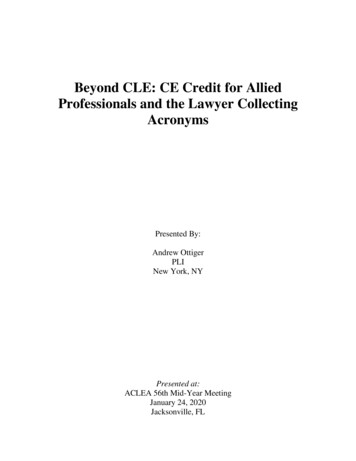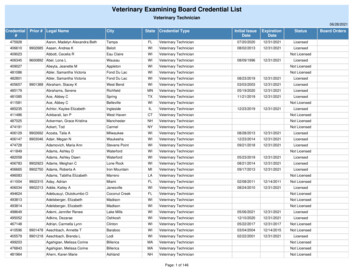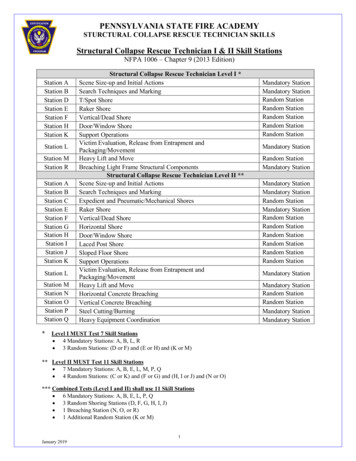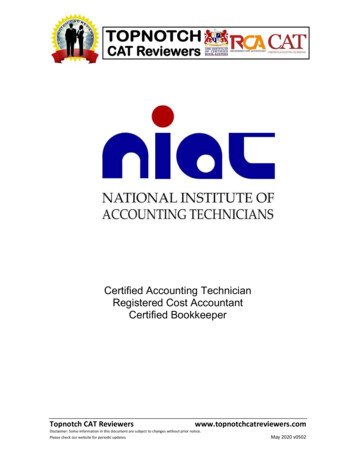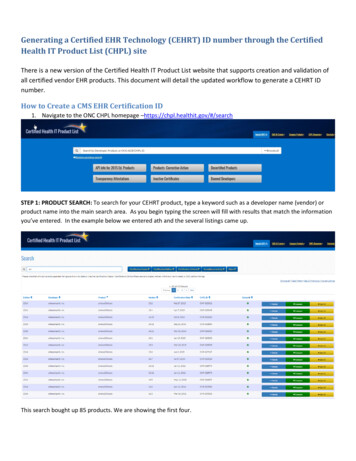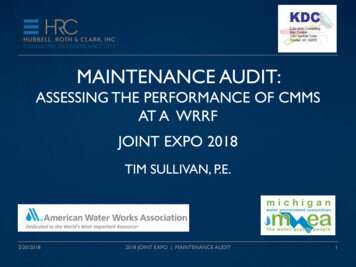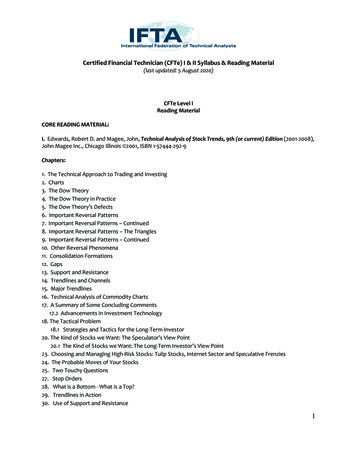
Transcription
Certified Financial Technician (CFTe) I & II Syllabus & Reading Material(last updated: 5 August 2020)CFTe Level IReading MaterialCORE READING MATERIAL:I. Edwards, Robert D. and Magee, John, Technical Analysis of Stock Trends, 9th (or current) Edition (2001-2008),John Magee Inc., Chicago Illinois 2001, ISBN 1-57444-292-9Chapters:1. The Technical Approach to Trading and Investing2. Charts3. The Dow Theory4. The Dow Theory in Practice5. The Dow Theory’s Defects6. Important Reversal Patterns7. Important Reversal Patterns – Continued8. Important Reversal Patterns – The Triangles9. Important Reversal Patterns – Continued10. Other Reversal Phenomena11. Consolidation Formations12. Gaps13. Support and Resistance14. Trendlines and Channels15. Major Trendlines16. Technical Analysis of Commodity Charts17. A Summary of Some Concluding Comments17.2 Advancements in Investment Technology18. The Tactical Problem18.1 Strategies and Tactics for the Long-Term Investor20. The Kind of Stocks we Want: The Speculator’s View Point20.1 The Kind of Stocks we Want: The Long-Term Investor’s View Point23. Choosing and Managing High-Risk Stocks: Tulip Stocks, Internet Sector and Speculative Frenzies24. The Probable Moves of Your Stocks25. Two Touchy Questions27. Stop Orders28. What is a Bottom - What is a Top?29. Trendlines in Action30. Use of Support and Resistance1
Certified Financial Technician (CFTe) I & II Syllabus & Reading Material(last updated: 5 August 2020)CFTe Level I (Continued)Reading Material33. Tactical Review of Chart Action34. A Quick Summation of Tactical Methods36. Automated Trendlines: The Moving Average38. Balanced and Diversified39. Trial and Error40. How Much Capital to Use in Trading41. Application of Capital in Practice42. Portfolio Risk Management43. Stick to Your GunsII. Murphy, John J.: Technical Analysis of the Financial Markets, New York Institute of Finance, New York, NY, 1999, ISBN 0-7352-0066-1Chapters:1. Philosophy of Technical Analysis2. Dow Theory3. Chart Construction4. Basic Concepts of Trend7. Volume and Open Interest14. Time CyclesIII. Pring, Martin J.: Technical Analysis Explained, 4th (or current) Edition, McGraw Hill Book Company, New York,NY, 2001, ISBN 0-07-138193-7Chapters:2. Financial Markets and the Business Cycle4. Typical Parameters for Intermediate Trends12. Individual Momentum Indicators II16. The Concept of Relative Strength18. Price: The Major Averages20. Time: Longer-Term Cycles22. General Principles26. Sentiment Indicators2
Certified Financial Technician (CFTe) I & II Syllabus & Reading Material(last updated: 5 August 2020)CFTe Level I (Continued)Reading MaterialIV. Le Beau Charles, Lucas David: Technical Traders Guide to Computer Analysis of the Futures MarketChapters:1. System Building2. Technical Studies4. Day TradingV. Nison Steve: Candlestick Charting Techniques, Second EditionChapters:1. Introduction2. A historical background3. Constructing the candlestick lines4. Reversal patterns5. Stars6. More Reversal Patterns7. Continuation Patterns8. The Magic Doji9. Putting it all TogetherVI. Du Plessis Jeremy: The Definitive Guide to Point and FigureChapters:1. Introduction to Point and Figure Charts2. Characteristics and Construction3. Understanding Point and Figure Charts4. Projecting Price Targets5. Analysing Point and Figure Charts3
Certified Financial Technician (CFTe) I & II Syllabus & Reading Material(last updated: 5 August 2020)CFTe Level I (Continued)Reading MaterialRequired additional IFTA reading material (see Appendices):1.2.3.4.Elliott Wave Theory (Appendix A–Provided when candidate registers for CFTe I.)Breadth Indicators (Appendix B– Provided when candidate registers for CFTe I.)Time Cycles Analysis (Appendix C– Provided when candidate registers for CFTe I.):Note: The questions on the exam for this topic will be pulled from Murphy, John J. recommended readinglisted above.Point and Figure Techniques (Appendix D– Provided when candidate registers for CFTe I.)RECOMMEDED (ADDITIONAL) READING:VII: Elder, Alexander Dr.: Trading for a Living, Psychology, Trading Tactics, Money ManagementChapters:1. Individual Psychology2. Mass Psychology3. Classical Chart Analysis4. Computerized Technical Analysis5. The Neglected Essentials6. Stock Market Indicators7. Psychological Indicators10. Risk Management4
Certified Financial Technician (CFTe) I & II Syllabus & Reading Material(last updated: 5 August 2020)CFTe Level IIReading MaterialCore ReadingsI. Edwards, Robert and Magee, John, Technical Analysis of Stock Trends, 9th EditionII. Martin J. Pring: Technical Analysis ExplainedChapters:1. The Market Cycle model2. Financial Markets and the Business Cycle16. The concept of Relative Strength18. Price: The Major Averages19 Price: Group Rotation20. Time: Longer-Term CyclesIII. Le Beau Charles, Lucas David: Technical Traders Guide to Computer Analysis of the Futures MarketChapters:1. System Building2. Technical Studies4. Day TradingIV. Steve Nison: Beyond Candlesticks: New Japanese Charting Techniques Revealed (Wiley Finance, Nov 10,1994)Chapters:2. The Basics3. Patterns4. Candles and the Overall Technical Picture5. How the Japanese use Moving Averages6. Three-Line Break Charts7. Renko Charts8. Kagi Charts5
Certified Financial Technician (CFTe) I & II Syllabus & Reading Material(last updated: 5 August 2020)CFTe Level II (Continued)Reading MaterialV. Jeremy Du Plessis: The Definitive Guide to Point and FigureChapters:1.2.3.4.5.Introduction to Point and Figure ChartsCharacteristics and ConstructionUnderstanding Point and Figure ChartsProjecting Price TargetsAnalysing Point and Figure ChartsVI. Yukitoshi Higashino, MFTA: Primer on ICHIMOKU (Appendix E)VII. J. Peter Steidlmayer and Steven B. Hawkins: SteidlMayer On Markets. Trading with Market Profile. SecondEditonChapters:6. Understanding Market Profile7. Liquidity Data Bank, On Floor information, and Volume @ Time8. The Steidlmayer Theory of Markets9. The Steidlmayer Distribution10. The You11. Anatomy of a trade12. Profile of a Successful Trader13. Trading, Technology, and the FutureVIII. A.J. Frost, Robert R. Prechter: Elliott Wave Principle: Key To Market BehaviorChapters:1. The Broad Concept2. Guidelines of the Wave Formation3. Historical and Mathematical Background of the Wave Principle4. Ratio Analysis and Fibonacci Time Sequence.6
Certified Financial Technician (CFTe) I & II Syllabus & Reading Material(last updated: 5 August 2020)CFTe Level II (Continued)Reading MaterialIX. Charles D. Kirkpatrick, Julie R. Dahlquist: Technical Analysis: The Complete Resource for Financial MarketsTechniciansChapters:3. History of Technical Analysis4. The Technical Analysis Controversy5. An overview of Markets7. Sentiment8. Measuring Market Strength9. Temporal Patterns and Cycles10. Flow of Funds13. Breakouts, Stops, and Retracements18. Confirmation19. Cycles21. Selection of Markets and Issues: Trading and Investing22. System Testing and ManagementX. Constance M. Brown: Technical Analysis for the Trading Professional, Second Edition (Added 7 March 2019;This material will be covered beginning in October 2019.Chapters:1.Oscillators Do Not Travel Between 0 and 100This chapter introduced range rules for RSI. The ability to define a trend based on the displacement ofthe oscillator was a very new concept for the use of oscillators. In bull markets a 14-period RSI will track40 to 80 . In bear markets and the transition into a bear market, the oscillator travels from 68 to 30 orlower.2. Dominant Trading Cycles Are Not Time SymmetricalRhythmical fluctuations can be more than just a fixed interval. This chapter will introduce cyclehistorians Samuel Benner and Edward Dewey showing an extension of their work into modern times.10. Using Oscillators with the Elliott Wave PrincipleThe chapter over the years has had the most feed-back. Readers have stated they did not ‘get it’ untilreading this real-time walk-through of how to develop Elliott Wave interpretations as a market evolvesover a time interval. It also shows the reader the steps that follow after the wave scenario has beenlost and how to resync with a market.12. The Composite Index7
Certified Financial Technician (CFTe) I & II Syllabus & Reading Material(last updated: 5 August 2020)RSI is the most widely used oscillator according to an industry survey from the magazine ‘TechnicalAnalysis Stocks and Commodities’. It has a fatal flaw. RSI will fail to diverge before a major trendreversal. The Composite Index is a formula that teaches the reader that one can embed the momentumformula inside of an RSI and solve this problem. The chapter explains the solution and how it is usedwith RSI to avoid this very common and costly indicator problem.RECOMMEDED (ADDITIONAL) READING:X. David Linton: Cloud Charts: Trading Success with the Ichimoku Technique [Hardcover]Chapters:8 . Cloud Chart Construction9. Interpreting Cloud Charts10. Multiple Time Frame Analysis11. Japanese Patterns Techniques12. Clouds Charts with other techniques13. Ichimoku indicator techniques14. Back-testing and Cloud Trading Strategies15. Cloud Market Breadth analysis16. Conclusion8
RSI is the most widely used oscillator according to an industry survey from the magazine ‘Technical Analysis Stocks and Commodities’. It has a fatal flaw. RSI will fail to diverge before a major trend reversal. The Composite Index is a formul

